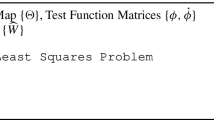Abstract
The paper deals with the problem of approximating a stable continuous-time multivariable system by minimizing the L 2-norm of a weighted equation error. Necessary and sufficient conditions of optimality are derived, and the main properties of the optimal reduced-order models are presented. Based on these conditions and properties, two efficient procedures for generating approximants that retain different numbers of Markov parameters and time moments are suggested and applied to benchmark examples. The results show that both the transient and the steady-state behaviour of the original systems are reproduced satisfactorily.
Similar content being viewed by others
References
Glover, K.: All optimal Hankel-norm approximations of linear multivariable systems and their L ∞ error bounds. Int. J. Control 39, 1115–1193 (1984)
Zigic, D., Watson, L.T., Collins, E.G., Bernstein, D.S.: Homotopy approaches to the H 2 reduced-order model problem. J. Math. Syst. Est. Contr. 3, 173–205 (1993)
Krajewski, W., Lepschy, A., Redivo-Zaglia, M., Viaro, U.: A program for solving the L 2 reduced-order model problem with fixed denominator degree. Numer. Algorithms 9, 355–377 (1995)
Ferrante, A., Krajewski, W., Lepschy, A., Viaro, U.: Convergent algorithm for L 2 model reduction. Automatica 35, 75–79 (1999)
Bierman, G.J.: Weighted least squares stationary approximation to linear systems. IEEE Trans. Automat. Contr. AC-17, 1313–1324 (1973)
Eitelberg, E.: Model reduction by minimizing the weighted equation error. IEEE Trans. Automat. Contr. AC-27, 1000–1002 (1982)
Lepschy, A., Viaro, U.: Model reduction using the output equation error. Int. J. Syst. Sci. 15, 1011–1021 (1984)
Regalia, P.A.: Adaptive IIR Filtering in Signal Processing and Control. Marcel Dekker, New York (1995)
Krajewski, W., Lepschy, A., Viaro, U.: On MIMO model reduction by the equation–error approach. Proc. 10th IEEE Int. Conf. Mathematical Models in Automation and Robotics, Wydawnictwa Politechniki Szczeci’nskiej (2004)
Yousuff, A., Wagie, D.A., Skelton, R.E.: Approximation via covariance equivalent realizations. J. Math. Anal. Appl. 106, 91–115 (1985)
de Villemagne, Ch., Skelton, R.E.: Model reduction using a projection formulation. Int. J. Control 46(6), 1121–1127 (1987)
Krajewski, W., Lepschy, A., Viaro, U.: Reduction of linear continuous-time multivariable systems by matching first- and second-order information. IEEE Trans. Automat. Contr. AC-39, 2126–2129 (1994)
Krajewski, W., Lepschy, A., Viaro, U.: Model reduction by matching Markov parameters, time moments, and impulse–response energies. IEEE Trans. Automat. Contr. AC-40, 949–953 (1995)
Antoulas, T.C.: Approximation of Large-Scale Dynamical Systems. SIAM Book Series: Advances in Design and Control (2005)
Moore, B.C.: Principal component analysis in linear systems: controllability, observability, and model reduction. IEEE Trans. Automat. Contr. AC-26, 17–32 (1981)
Kailath, T.: Linear Systems. Prentice-Hall, Englewood Cliffs, NJ (1980)
Krajewski, W.: Selected methods for optimal model reduction. Akademicka Oficyna Wydawnicza EXIT, Warsaw (2006) (in Polish)
Inouye, Y.: Approximation of multivariable linear systems with impulse response and autocorrelation sequences. Automatica 19, 265–277 (1993)
Agathoklis, P., Sreeram, V.: Identification and model reduction from impulse response data. Int. J. Syst. Sci. 21, 1541–1522 (1990)
Boley, D.L.: Krylov space methods on state-space control models. Circuits Syst. Signal Process. 13, 733–758 (1994)
Antoulas, A.C., Sorensen, D.C., Gugercin, S.: A survey of model reduction methods for large-scale systems. Technical Report TR00-38, Dept. of Comp. and Applied Math., Rice University, Houston, Texas 77251-1892 (2000)
Author information
Authors and Affiliations
Corresponding author
Rights and permissions
About this article
Cite this article
Krajewski, W., Viaro, U. On MIMO model reduction by the weighted equation–error approach. Numer Algor 44, 83–98 (2007). https://doi.org/10.1007/s11075-007-9086-2
Received:
Accepted:
Published:
Issue Date:
DOI: https://doi.org/10.1007/s11075-007-9086-2




